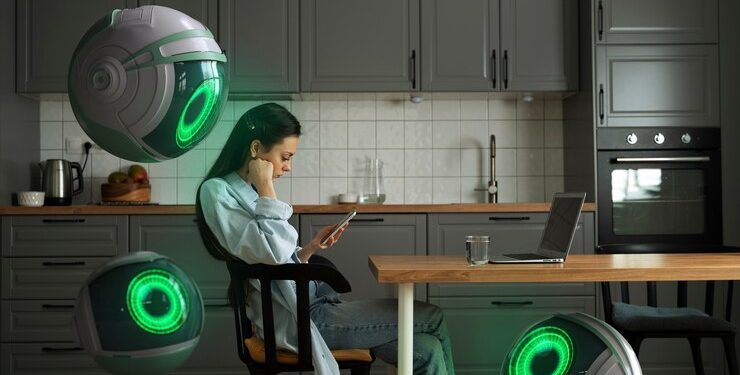Introduction
In the tapestry of technological evolution, robotics has woven its threads into the fabric of our daily existence, transforming the way we live, work, and interact. From the automated precision of manufacturing to the intricate dance of personal assistants, robotics has transcended its industrial origins to become an integral part of our everyday lives. In this exploration, we delve into the diverse realms where robotics has found a home, from smart homes to personal assistants, shaping a future where machines seamlessly coexist with human experiences.
- Smart Homes: A Robotic Symphony
The concept of smart homes has burgeoned into a reality, with robotics at its core. Robotic devices, often disguised as household appliances, collaborate to create an ecosystem that enhances convenience, security, and energy efficiency.
Automated Lighting and Climate Control
In smart homes, robotic systems control lighting and climate based on user preferences and real-time conditions. Machine learning algorithms adapt to user behaviors, optimizing energy consumption and creating personalized living environments.
Robot Vacuum Cleaners
The hum of robot vacuum cleaners has become a familiar sound in modern households. These autonomous devices navigate rooms, avoiding obstacles and efficiently cleaning floors. Their integration with smart home ecosystems allows users to schedule cleanings or control them remotely.
Security Robotics
Drones and surveillance robots are transforming home security. Equipped with cameras and sensors, these robots patrol properties, providing real-time monitoring and alerts. Their ability to navigate complex environments makes them invaluable for enhancing safety.
- Robotic Personal Assistants: Your AI Companion
The emergence of robotic personal assistants marks a significant leap in human-computer interaction. These intelligent entities go beyond traditional virtual assistants, integrating physical capabilities to enhance their utility.
Voice-Activated Assistants
Devices like Amazon’s Alexa and Google Assistant leverage voice recognition and natural language processing to execute commands. They serve as control centers for smart homes, managing connected devices and providing information on demand.
Robotic Arms and Manipulators
In industrial settings, robotic arms have long been used for precision tasks. Now, these technologies are finding their way into homes, assisting with chores and tasks that require dexterity. From folding laundry to pouring drinks, robotic arms are becoming versatile household aids.
Social Robots
Advances in social robotics have given rise to companionship robots designed to engage with humans emotionally. These robots, like Pepper and Jibo, interact through conversation and expressive movements, offering a unique blend of entertainment and companionship.
- Medical Robotics: Precision in Healthcare
Robotics has made significant inroads into the field of healthcare, enhancing surgical precision, rehabilitation, and patient care.
Robotic Surgery
These robots translate the surgeon’s movements into precise actions, reducing the invasiveness of surgeries and facilitating faster recovery times.
Rehabilitation Robots
Robotics is aiding rehabilitation efforts with devices like exoskeletons. These wearable robotic structures assist individuals with mobility impairments, enabling them to regain or enhance their motor functions through targeted exercises.
Telepresence Robots
Telepresence robots enable remote healthcare consultations, connecting patients with healthcare providers without the need for physical presence. These robots navigate medical facilities, allowing physicians to interact with patients and medical staff as if they were there in person.
- Educational Robotics: Learning Beyond the Classroom
Robotics is increasingly becoming a hands-on educational tool, fostering creativity, problem-solving skills, and technological literacy among students.
Robotics Kits and Programming Platforms
Educational robotics platforms, like LEGO Mindstorms and Raspberry Pi, empower students to build and program their robots. These hands-on experiences demystify technology, making it accessible and engaging for learners of all ages.
Coding and Computational Thinking
Integrating robotics into education facilitates the teaching of coding and computational thinking. Students learn to program robots to perform specific tasks, cultivating skills that are increasingly vital in a technology-driven world.
STEM Education Initiatives
Robotics is a key component of Science, Technology, Engineering, and Mathematics (STEM) education initiatives. These programs aim to inspire the next generation of innovators and problem solvers by providing hands-on experiences in robotics and related fields.
Conclusion: Navigating the Robotic Frontier
The integration of robotics into everyday life signifies a transformative shift in how we perceive and interact with technology. From the autonomous precision of smart homes to the adaptive intelligence of personal assistants, and the precision of robotic surgery to the educational empowerment of robotics in schools, these machines are shaping a future where human and robotic collaboration is seamless.
As we navigate this robotic frontier, ethical considerations, privacy concerns, and the responsible development of artificial intelligence become paramount. Striking a balance between innovation and ethical considerations will be crucial in ensuring that robotics continues to enhance our lives without compromising fundamental values.
The journey of robotics from factory floors to living rooms exemplifies the boundless potential of technology to augment and elevate the human experience. As robots become more sophisticated and integrated into our daily routines, the collaboration between human ingenuity and artificial intelligence holds the promise of a future where technology serves as a seamless, empowering companion in our journey through life.



